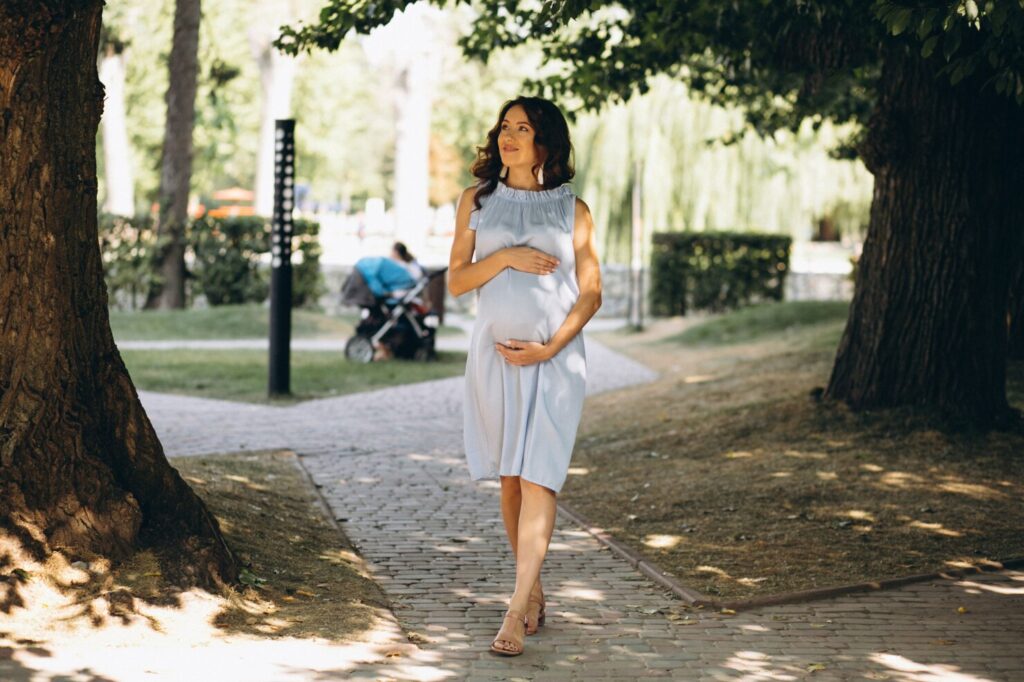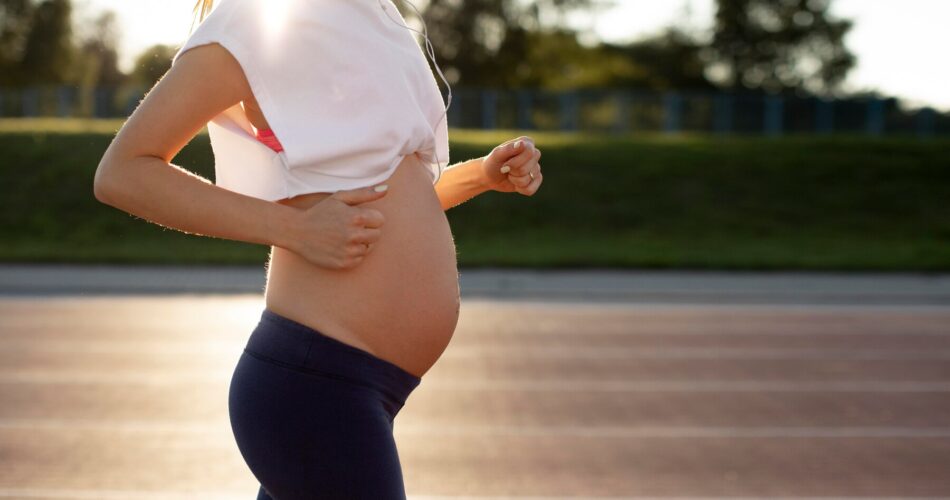- The Benefits of Walking During Pregnancy
- Rules for Walking During Pregnancy
- Duration of Walks
- How to Walk Properly
- Monitoring Well-being
- Rest
- Features of Walking During Different Trimesters
- The Importance of Walking in the Third Trimester
- Pain sensations while walking: why they occur
- When walking is contraindicated
- When else should you avoid walking
Is walking during pregnancy beneficial or harmful, how long and how fast can you walk in such a condition – all these questions concern women who are soon to become mothers. The most important thing they should understand is that pregnancy is not a disease but a temporary state of the body. Therefore, there is no need to give up the habits that the woman had in her ‘past life.’
Moreover, there is no need to abstain from physical activity. However, everything now should be done carefully and cautiously, ‘without fanaticism,’ and consulted in advance with the doctor overseeing the pregnancy. Walking during pregnancy is the optimal form of physical exertion. Daily walks in the fresh air have minimal contraindications and bring great benefits to expectant mothers.
The Benefits of Walking During Pregnancy
Walking during pregnancy is not only beneficial but also necessary. During walks in the fresh air, the body is saturated with oxygen, and all the muscles of the body are kept toned. In addition:
- active blood circulation serves as a workout for the cardiovascular system, helping to prevent varicose veins;
- blood pressure normalization occurs due to the oxygenation of the blood;
- the gastrointestinal tract functions are normalized – walking during pregnancy accelerates the movement of food through the intestines, prevents bile stagnation, and toxins are timely removed from the body;
- the immune system is boosted, especially when walking in any weather. Excluding icy and hot conditions;
- emotional state is stabilized in early pregnancy stages;
- the woman’s body prepares for the upcoming birth, practicing breathing which is crucial for labor, helping avoid hypoxia for the baby and reducing pain for the mother.

Rules for Walking During Pregnancy
To gain the most benefit from walking during pregnancy, certain rules should be followed. It is necessary to:
- choose comfortable and weather-appropriate clothing – loose, made of soft fabric, and shoes – sneakers;
- select parks, gardens, or alleys as places for walks;
- carry non-carbonated water, drink it often and in small sips;
- walk correctly – keep your back straight, step first on the heel, then on the toe;
- rest during the walk, slow down the pace, sit on a bench in the park;
- monitor your pulse – with a heart rate monitor or smart watch, or by measuring pulse on the wrist;
- bend your arms at the elbows and move them actively to increase exertion;
- avoid walking for too long during pregnancy;
- choose a pace, starting with half-hour walks.
Duration of Walks
Walking during pregnancy should be a daily activity. For untrained women who have previously shown little physical activity, 20 minutes to half an hour is sufficient to start. Gradually, the duration of walks should be increased to 1-1.5 hours a day. In early stages and good weather, the duration may be longer. If a woman is unsure whether long walks could harm her during pregnancy, or if it’s simply too difficult for her to walk for long periods later in pregnancy, the walk can be divided into 2-3 stages. For example, going for a walk in the morning and evening. A walk before bed is especially beneficial for a sound, restful sleep.
If the expectant mother works, she should try to use the commute to and from work for walking. For example, getting off public transport one stop earlier and covering the remaining distance on foot. However, it is not advisable to walk along roads congested with traffic.

How to Walk Properly
Before going for a walk, it’s worth doing a little warm-up that includes arm exercises, a few light leg swings, and foot stretching. No matter the level of athletic training of the expectant mother, walking during pregnancy should be correct to be effective and provide maximum benefit.
Experts advise:
- keep your back straight, shoulders not slouched, and do not hunch over;
- direct your gaze into the distance, a few steps ahead – this helps spare your neck from strain;
- monitor your breathing – it should be even and deep;
- try to maintain the chosen pace by determining the optimal speed of movement;
- do not aim for fast walking or covering long distances during pregnancy — the main thing is to enjoy nature and converse with the future child;
- it is perfectly acceptable to wear headphones — listening to pleasant music has a beneficial effect on the psyche of a pregnant woman and her baby.
Monitoring Well-being
Among the rules to be followed when walking during pregnancy is the constant monitoring of well-being and an adequate response to its changes.
Today, there are many devices capable of analyzing a person’s condition on the go in the literal sense. A compact heart monitor checks the state of heartbeat and pulse, advises on the duration of a pregnant woman’s walk and the correct choice of pace. For additional load monitoring, a pedometer can be used.
However, you don’t have to use trendy gadgets. It’s simple – if a woman can talk and not feel discomfort while walking without getting breathless, the pace is correct. You should also periodically count your pulse beats.
At the first signs of fatigue – slow down, walk slowly, stand or if possible – sit down. If this doesn’t help, you need to end the walk and slowly return home.
Rest
The effectiveness and benefits of walking during pregnancy increase with proper rest after finishing. The most sensible thing after a walk is to rest, especially if it ended due to fatigue or signs of discomfort. Initially – on a park bench, and immediately after arriving home, it’s worth lying down,
placing your legs on a pillow to avoid swelling.
A relaxing effect can be achieved with a warm (not hot) foot bath, for example, with sea salt, essential oil, or herbal decoctions. Its duration should not exceed 10-15 minutes. After the foot bath, you can lie down with a pillow under your legs for about half an hour. This position, with the legs slightly elevated, is excellent for preventing varicose veins and swelling.
Features of Walking During Different Trimesters
The choice of walking duration and pace during pregnancy depends on the trimester. In the early stages, you can walk quickly, for long periods, and actively, if you feel well and there’s no discomfort. However, starting from the second trimester, it’s advisable to slow down slightly, especially if the woman is predisposed to developing varicose veins. During this period, rest after walking and preventive measures are necessary to prevent it.
This is also necessary when swelling of the lower limbs appears.
In late pregnancy, the load should be minimal—during the third trimester. During this period, the intensity and duration of walking should be significantly reduced; however, if there are no contraindications, it’s not advisable to stop completely.
The Importance of Walking in the Third Trimester
In the third trimester, many expectant mothers experience symphysitis—a painful condition associated with inflammation of the pubic joint. The symphysis is a cartilage located in the pubic area connecting the pelvic bones. In late pregnancy, as the pregnancy progresses, the pelvic bones separate due to the stretching of the soft tissues of the symphysis. This is necessary for the passage of the baby’s head during childbirth.
For many women, the separation of the pelvic bones is a painful process. If an expectant mother has been walking throughout her pregnancy and continues to do so in the third trimester, the bones separate painlessly and smoothly. During this period, walking strengthens the abdominal walls, which will aid in pushing and easing childbirth. It is better not to walk for long distances or alone at this time – it’s preferable to choose the company of a close person.
Pain sensations while walking: why they occur
During active walks, a pregnant woman’s body undergoes colossal changes that can cause painful sensations. Among them:
- sciatic nerve pinching – the growing uterus may pinch the nerve, pain is felt only on one side;
- calcium deficiency – feeling pain in certain joints, a vitamin complex for expectant mothers or a calcium supplement may be needed;
- flatfoot in pregnant women – can develop with weight gain and swelling, manifests as quick fatigue and leg pain;
- symphysitis – sharp, stabbing pain in the pubic area occurs due to the softening of the pubic symphysis;
- overstrain of the ligaments holding the uterus – pain appears on the sides of the abdomen, which can be relieved by a properly fitted belly band;
- varicose veins – legs swell, ache, throb, feel heavy, especially by the end of the day; anti-varicose stockings can alleviate the condition.
When walking is contraindicated
There are several taboos on active walking during pregnancy. Walking is absolutely prohibited if a woman has flu, acute respiratory viral infection, or aggravated gastritis – in these cases, walking will cause harm. Moreover, if there is a rise in temperature, weakness, or headaches occur.
If a woman has uterine hypertonus, walking is out of the question. In such a condition, complete rest is necessary, and in the most serious cases, immediate hospitalization is required to preserve the fetus. This refers to situations when the abdomen hardens and tightens, there are cramping or pulling pains, a feeling of pressure in the perineal area. And it’s even more crucial to urgently call an “ambulance” if blood appears on the pad — these symptoms indicate a threat of miscarriage.
When else should you avoid walking
When examining the benefits and risks of walking during pregnancy, it’s clear that there are more positive aspects than negative ones. It is important to follow guidelines and not ignore contraindications. For instance, do not take walks if the pregnant woman has protein in her urine, severe vomiting, high blood pressure, or swelling of the extremities.
In such cases, particularly in the later stages, it signals a serious kidney dysfunction. No physical activity is allowed in these situations, and immediate medical attention is required. Additionally, an unfavorable medical history is a contraindication, such as if a previous pregnancy ended in miscarriage. Such a pregnant woman is at risk, and therefore, short, slow-paced walks will be sufficient for her.



Download the app and get 7 days free use
 eng
eng rus
rus deu
deu spa
spa fra
fra ita
ita por
por srp
srp tur
tur ukr
ukr por
por bos
bos



